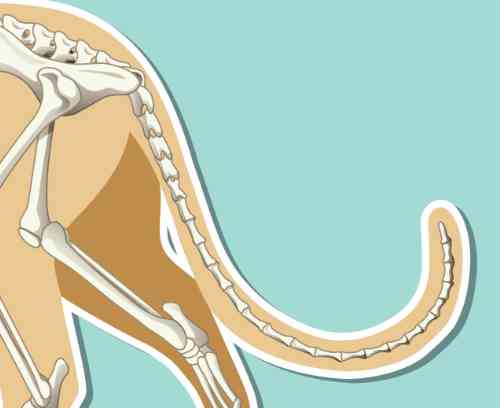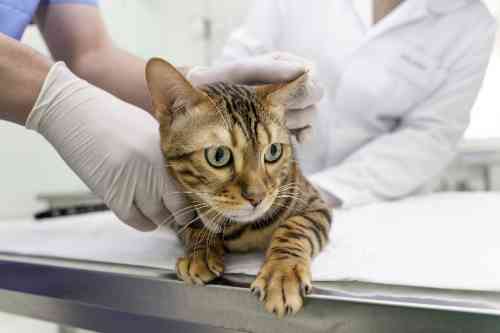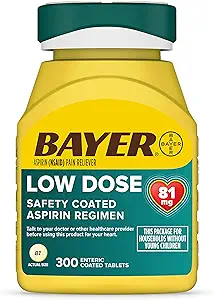Your cat has a broken tail
Best way to handle it
Do you suspect that your cat has broken his tail? That really sucks. Both for your cat and for you. In this article we explain how you determine whether your cat has really broken his tail. And what other symptoms you also might see. We will tell you more about the possible cause and how you can get more information about the cause from your cat. And of course we will tell you more about the treatment of a cat with a broken tail.
Determine if your cat has a broken tail
In most cases, an owner is unsure whether the cat broke his tail or not. You determine this by carefully feeling the tail. If the tail is broken, the tail vertebrae no longer run in a nice straight line. Or the vertebrae can shift slightly relative to each other. More than the other vertebrae can do this. Of course, you can imagine that this can hurt your cat. So do this examination carefully and calmly. Starting at the base of the tail, feel each vertebra and disc by sliding them slightly back and forth in relation to each other. There shouldn’t be movement between the two. So if you feel that there is movement between the vertebrae, then your cat’s tail is broken.
Symptoms in case your cat has a broken tail
There are a number of symptoms when your cat has broken his tail. However, these symptoms can also be seen with other problems with the tail and therefore do not necessarily indicate that the tail is broken.
- The tail has become (locally) swollen and thick
- The skin of the tail may look red at the site of the problem
- his tail may hang down
- A kink may be visible in his tail
- His tail will feel painful when you touch it.
- The tail may feel warmer than normal
- Sometimes larger or smaller wounds may also be visible on your cat’s tail
- In rare cases, you may even see a piece of bone protruding through the skin.
What you should certainly not notice is that your cat has a fever or a purulent discharge from part of his tail. In that case, there is an abscess on your cat’s tail. This also hurts your cat terribly, but the tail is usually not broken.
Your cat’s tail may also be bruised. In that case, he may have all the symptoms we mentioned above, but then you will feel that the tail vertebrae run in a normal straight line and there is no movement between the tail vertebrae. There is also no obvious kink in the tail, although your cat may hold his tail in a downward position due to the pain.
Causes of a broken tail in a cat
Somehow, your cat broke his tail when an external force against his tail exceeded the forces his muscles, tendons, and tail vertebrae could handle. This could, for example, be the result of a collision with a car or bike. Or his tail got stuck somewhere and he made a strange movement to get it loose. Or a door closed behind him a little too quickly and his tail was still stuck in it.
Intense fights can sometimes also be the cause. And don’t forget that cat-hating neighbour who may have grabbed your cat’s tail and done who-knows-what to your cat. Believe it or not, this still happens quite regularly.
If a cat has been hit by a car, it almost always has frayed nail tips. This is because he has reflexively extended his nails to brace himself against the impact and to remain upright. His nails are then abraded during the collision, because his body is pushed away. And also look for small pointed wounds on the rest of his body. in that case, your cat has probably been in a fight with another cat.
When should you go to the vet if your cat appears to have a broken tail?
In principle, it is always wise to take your cat to a vet to have it checked if you suspect that he has a broken tail. During the physical examination, your vet can assess, in addition to a broken tail, whether there may also be an internal bleeding in your cat’s abdomen. After all, a collision often causes more damage than just a broken tail.
But even if you just want to be sure whether your cat has a broken tail or not, your vet can take an X-ray of your cat’s tail. This will show whether there is a fracture. And if so, whether the fracture is in a vertebra or in an intervertebral disc.
Do you see a piece of bone sticking out or does your cat have large wounds on his tail? Then it is always necessary to go to your vet. Bone tissue will infect very quickly. And ultimately, your cat can die from blood poisoning if you don’t do anything about it.
Your vet can also prescribe a painkiller so that your cat experiences less pain from his broken tail in the days after the break occurs. He will appreciate this a lot.
How do you treat a broken tail in a cat?
Placing a splint
If there is a clear perpendicular kink in the tail, the tail is almost always broken. In that case, it is better to have the tail splinted by your vet so that your cat’s broken tail can grow back into a straight position. In some cases it is better to reattach the broken tail vertebrae under anaesthesia with very small metal plates. You can compare this a bit with an internal splint. In principle, such a metal plate does not need to be removed once the fracture has healed. Unless complications arise later in your cat’s life.
Tail amputation
Do you see bone tissue protruding from the skin of your cat’s tail? Unfortunately, most of the times it is best to amputate your cat’s tail. In other words, they take off a piece of his tail. After all, there is a good chance that an infection will occur that could kill your cat. To minimize that happening, they remove the part of the tail from about 5 centimeters before the break. This way they create a fresh wound and the chance of a wound infection is minimized.
Allow it to heal naturally
But in the vast majority of cases, we let nature take his course if your cat has a broken tail. That is, as a veterinarian we only give your cat pain relief and advise you to give him a lot of rest. But that’s usually all it takes for the broken tail to heal. After all, it is not too bad if your cat is left with a bit of a crooked tail after this adventure. He can live well with a slightly crooked tail and will no longer have any pain from it once it has healed.
Also splinting a tail is not without danger. The sides of the splint may cause the skin to get inflamed or the bandage used to secure the splint may be too tight, causing your cat’s tail have no bloodflow. That is why, as a veterinarian, we only intervene medically in the case of a cat’s broken tail if the tail is extremely crooked or drags on the ground.
After all, if the tail drags on the ground, abrasions will eventually occur. And they will in turn become infected, causing your cat to die from the consequences of that infection. So that must be prevented.
A vet visit is therefore not absolutely necessary
So does your cat not suffer too much from his tail and is it not extremely crooked? And are there no visible wounds? Then a vet visit is not strictly necessary. In that case, you can also keep a close eye on his tail for about 6 weeks. During those 6 weeks his tail will heal and he will start using his tail a little more each week. And whether that is in a crooked position, it doesn’t matter much.
What else can you do if your cat has a broken tail?
Give him some rest
If your cat has broken his tail, it is important that the tail gets some rest and that your cat has a nice warm place to relax in. In other words, that your cat stays indoors as much as possible and that as few forces as possible can act on your cat’s tail. So make sure that small children do not sit with him all the time and pet him. They can unintentionally touch his tail, which limits healing. And most cats can become quite grumpy and bite or scratch your child.Administer a painkiller
You can also give your cat a painkiller. It is best to use a painkiller from your vet such as Metacam, Rimadyl, Carprodyl, Meloxicam or Onsior. But most people will not have this at home and your vet may only prescribe it if your cat has had a consultation. So you decide not to take your cat to your vet? Then you often don’t have a painkiller to support your cat’s broken tail. In that case you can use Aspirin. NOTE! NO OTHER HUMAN PAIN KILLER IS SUITABLE TO GIVE TO YOUR CAT. THEY’RE GOING TO DIE! But Aspirin is suitable. You can give your cat half a tablet of a low dose Aspirin tablet of 81 mg once every 2 days (not twice a day!). It is preferable to give this a maximum of 7 days. After that, the worst of the pain for your cat will have subsided. The tail should have healed again after 4-6 weeks. The younger your cat is, the faster the healing will be. Of course it is a more vulnerable place afterwards, so keep that in mind.Heat
You can also place heat pads next to the fracture in the tail of your cat. Heat will open up the blood vessels in his tail and therefor improve the amount of healing substances towards the fracture due to the increased blood flow. For example, place a cherry pitt cushion 3 times a day for about 15 minutes against his tail. But make sure it is not too hot.What should you take into account for later if your cat has a broken tail?
Once your cat’s tail has recovered and all the vertebrae have grown back together, most cats will no longer have any problems. But according to research, some cats may suffer from problems with their balance or experience problems in communicating with other cats because a lot of communication happens with the help of the tail. It is therefore important that you keep an eye on whether your cat suddenly gets into fights much more often if it has a crooked tail or if he has many more accidents because, for example, it can no longer balance on fences.
How do you prevent a broken tail in your cat?
It is of course difficult to prevent a broken tail in your cat. But by offering him challenges inside the house as much as possible, he will go outside less often and will therefore be less likely to have a collision with a car or moped.
If you have a male cat, it is also wise to have him neutered so that he will fight with other cats less often.
And of course try to keep them away from that angry neighbor as much as possible.








